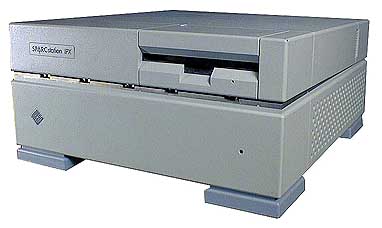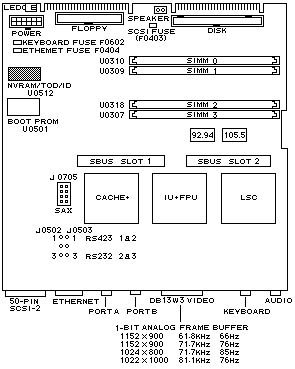SUN4/50 SparcStation IPX

Obsolyte.com is hosted on a Sparc IPX, running RedHat Linux 6.0 for Sparc (UltraLinux) and the Apache Web Server. This particular machine has 64MB of Ram (the maximum this type of machine can take) and a 500 Meg HD. BogoMips = 79, which makes it about as fast as a Pentium-75 PC.
The SparcStation IPX was one of the most popular "lunchbox" machines made, so they are easy to find and find parts for. They use standard 72pin SIMMs, and as long as they are true partity (36bit), you can pretty much use any 72pin SIMMs.
I've been wildly creating hardware hacks for this machine. There are all kinds of fun things to do with it. Externally, I have added 3 (so far) LEDs glued into the floppy bay. They are: HD, Power, and Memory(?) access. Internally, I have added extra wiring for all this, as well as extra fans to keep the machine cool.
Hardware FAQ Info
SPARCstation IPX (4/50)
Processor(s): Fujitsu MB86903 or Weitek W8701 @ 40MHz, FPU on
CPU chip, Sun-4c MMU, 8 hardware contexts,
28.5 MIPS, 4.2 MFLOPS, 21.8 SPECint92,
21.5 SPECfp92, 517 SPECintRate92, 510
SPECfpRate92
Chassis type: lunchbox
Bus: SBus, 2 slots
Memory: 64M physical; 64K write-through cache,
direct-mapped, virtually indexed, virtually
tagged, 32-byte lines
Architecture: sun4c
Notes: Code name "Hobbes". 4M or 16M x 33 72-pin SIMMs.
Onboard GX-accelerated cg6 color framebuffer
(not usable with mono monitors, unlike SBus
version). Picture of Hobbes (from Watterson's
"Calvin and Hobbes" comic strip) silkscreened on
motherboard. 1.44M 3.5" floppy.
Motherboard
The IPX has pretty decent performance for a machine of its age, mostly due to a large (1MB) cache for the CPU. While not a graphics powerhouse by today's standards, the built-in CG6 framebuffer is as good as most SBUS based cards.
The Cache is the large chip on the left with the gold center, the CPU is next to it - as the all black chip, and the all grey chip on the right side is the framebuffer controller. Note the 8 rectangular chips right below the framebuffer chip. This is the VRAM for the video.
Above the 3 "main" chips are the 2 black strips of SBUS connector, above those are the white strips that are the main RAM slots.
Those of you with sharp eyes will have already caught that the black CPU isn't a standard IPX CPU. It's the famous 'Weitek Power Up' chip, an internal "clock doubler" type of chip that runs internally at 80Mhz. It has a 40Mhz interface, so it's a literal "plug and play" upgrade to the IPX. This chip, plus the cache, gives the IPX more than enough horsepower to be a decent webserver. Heck, I've been running SETI@home on it as well with no degradation of performance (well, not much). For those of you thinking about running SETI, I just did it for kicks, this is not a decent machine for that task -- a single workunit takes about 100 hours to complete. I've got a 750Mhz Athlon at home that does a workunit in 4 hours.
Those of you with even sharper eyes may have noticed the kitty-cat silkscreened onto the motherboard. Even after packing all these chips into such a small space, they had room left over, eh? Click on the image to see a picture of the entire motherboard, with the cat for scale. (Filesize for image is 110K, so it may take a few seconds to download.)
The IPX and the SparcStation 2 are very similar performance-wise. Both use the same CPU, both clock in at 40Mhz, but can take the "power up", and both can take the RAM SBUS card that allows for another 64MB of RAM, for a total of 128MB. The SS2's only advantages are that it can hold an additional hard drive and I believe it has more hardware contexts. This gives it a slight edge. However, considering you get the framebuffer built-in here (though for people like me (who run headless), that's really no advantage), it's a pretty good deal in a small package. The lunchbox form factor makes it ideal for crowded equipment areas, or where desk space is at a minimum.
Total
MemoryMEM1
U0407MEM2
U0408MEM3
U0409MEM4
U04108MB 4MB 4MB 12MB 4MB 4MB 4MB 16MB 4MB 4MB 4MB 4MB 16MB 16MB 20MB 16MB 4MB 24MB 16MB 4MB 4MB 28MB 16MB 4MB 4MB 4MB 32MB 16MB 16MB 36MB 16MB 16MB 4MB 40MB 16MB 16MB 4MB 4MB 48MB 16MB 16MB 16MB 52MB 16MB 16MB 16MB 4MB 64MB 16MB 16MB 16MB 16MB 
Port Pinouts
From the Hardware FAQ+ DIN-8 audio port on SPARCstation IPX, others? ------- / === \ / \ / 6 7 8 \ | | | 3 4 5 | \ / \ 1 2 / \_______/ 1 not connected 4 not connected 7 GND 2 not connected 5 not connected 8 audio out 3 audio in - 6 audio in + + DIN-8 serial port on SPARCstation IPC, IPX, others? ------- / === \ / \ / 6 7 8 \ | | | 3 4 5 | \ / \ 1 2 / \_______/ 1 DTR 4 GND 7 DCD 2 CTS 5 RxD 8 RxC (receive clock) 3 TxD 6 RTS
LunchBox Hacks
Lunchbox Ultimate Fan Hack
Sparc / Lunchbox Status Lights Hacks
LunchBox Drive Fan Hack
Sparc/Linux Tips
Sparc Lunchbox Speaker-Fan Hack
Common Questions Regarding This Hardware
My NVRAM is dead. What can I do?
If you're getting messages about a bad IDPROM, or your ethernet address is coming up as ff:ff:ff:ff:ff:ff, and the machine is refusing to boot, then your NVRAM is probably dead. The item is a DIP style, socketed chip with battery backed RAM holding parameters about your machine (and a clock). When the battery dies, it's time to order a replacement, and then reprogram the NVRAM with a new hardware ethernet address and some other parameters. Please read the NVRAM FAQ to learn how to resurrect your machine from the dead.
I don't have a Monitor. Can I connect through the serial port?
Yes. All you need is a null modem cable (not a laplink cable!) and something that will act as a terminal at 9600, 8N1. Please read my Serial How-To to see the full details on running a Sparc in a "headless" state.
Can I use a VGA Monitor, and a PC keyboard?
Yes, sorta, and somewhat, sorta... Sparcs use a proprietary 13w3 connector (except until recently, when Sun switched to using PCI cards, and now use a standard VGA connector), which can be adapted to a VGA Style connector, but the sparc framebuffers usually put out 1152x900 at 66Mhz, which many of the cheaper VGA monitors do not sync to. You'll need the adapter and a decent monitor. Sun machines also require a proprietary Sun keyboard and mouse, but of course, someone out there does make a box that converts the signals so you can use a PC keyboard on a Sun (or use a Sun keyboard on a PC). However, I've never seen one of these things in real-life, and I find it's easier to obtain a real Sun keyboard than all the wacky converter do-hickies required to make it work.
How do I boot from a CDROM?
You'll need a bootable ISO image CDROM. You'll need a SCSI CDROM drive with a 512k block size (most Toshiba and NEC mechanisms support this) set to SCSI ID #6. At the prom prompt, type "b cdrom" or "boot cdrom", depending upon which prom revision you're using - in many cases, either will work, but if one doesn't the other will. If you're looking for a copy of Linux, www.linuxiso.org has downloadable ISO images you can burn onto a CD yourself. If you don't have a burner, cheapbytes sells very inexpensive copies.
How do I boot from a Network?
There's a pretty good net-boot HOW-TO at:
http://sunsite.tut.fi/SPARCLinux/sparc/howto/netboot-1.html, but if anyone wants to get their's listed here also, send me a URL!